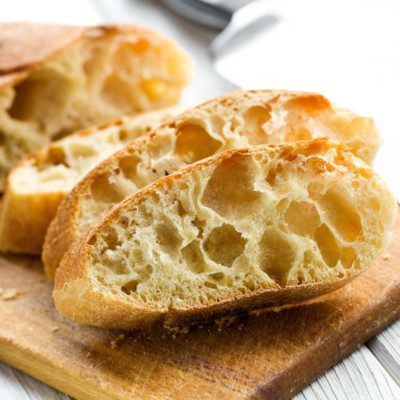How is ciabatta made?
The main characteristic of ciabatta is its lean formulation (very little fat added but no sugar or dough conditioners is added) and very high hydration level.
To provide the best flavor, texture, and shelf life, ciabatta can be made with yeast-based preferments (e.g. sponge, poolish, biga) or natural preferments (e.g. sourdough starter or levain, liquid levain).
The formula for making a ciabatta, using a poolish as pre-ferment, is as follows:1,2
| Poolish formula | |
| Ingredient | Baker’s % |
| Bread flour (patent) | 100.0 |
| Water | 100.0 |
| Compressed yeast | 0.3 |
| Total | 200.3 |
* Mix all ingredients until well incorporated at a temperature of 70 °F. Allow to ferment 12–16 hours at room temperature (64–70 °F).
| Dough side formula | |
| Ingredient | Baker’s % |
| Bread flour (patent) | 100.0 |
| Water | 68.0* |
| Salt | 3.0 |
| Virgin olive oil | 4.0 |
| Poolish | 120.0* |
| Total | 295.0 |
* Amount of poolish and dough water are function of water absorption target (usually 80%).
Specifications for ciabatta flour include:3
- Protein content, 12.5–14.0%.
- Ash content, 0.45–0.55%.
- Particle size, 120–180 µm (microns).
- Falling Number, 200–300 (sufficient amylase activity to support fermentation without added sugar).
- Class of wheat used, Hard red spring (HRS), Hard red winter (HRW), Hard white (HW). A minimum level of damaged starch is required.
- Flour with low enzymatic activity (Falling Number >450) should be supplemented with diastatic malt in formula.
Processing specifications:1,2
- Mix final dough at low speed for 3 min to incorporate water into flour, then mix at high speed for 8–10 min. Final dough temperature should be 73–74 °F.
- Bulk fermentation: 2–3 hours at room temperature.
- Makeup (sheeting and dividing): dough mass is conveyed through a channel to a set of rollers to be gradually and gently sheeted to a pre-set thickness, essential for preserving the honeycomb-type structure. Sheeted dough is cut into long strips with discs placed on top and spread on conveying belt with guide rails. Finally, the strips are cut to the desired dimensions (shape) and weight via a guillotine.
- Proofing on floured peel board or automated line: 30–45 min at 77–86 °F, 60–70% RH.
- Baking: hearth or deck oven at 428–446 °F for 28–35 minutes. Short spurts of steam injection may be introduced.
Application
For dusting flour, a mixture of semolina (⩾230 µm) and rice flour can be used to avoid dough sticking to surfaces.
Only gentle stress/strain, via adjustable sheeting thickness or conveying speed, should be applied to dough to reduce damage to gluten matrix and preserve the open cell structure. High-speed bakeries often use dedicated makeup lines for ciabatta and other delicate hearth breads (e.g. baguette).4
Mixing method known as “double hydration technique” can be applied in high-speed ciabatta production lines by adding water in two phases:5
- 80–90% of total water added at the beginning of mixing to make a dough of medium consistency. Then, the dough and pre-ferment, if used, are mixed until cleanup stage (approximately 2/3 of full gluten development).
- The remaining water (20–10%) is added slowly along with dry ingredients until fully incorporated into the dough.
References
- Suas, M. “Bread Formulas” Advanced Bread and Pastry: A Professional Approach, Delmar Cengage Learning, 2009, pp. 177–192.
- Gisslen, W. “Lean Yeast Doughs: Sponges, Pre-ferments, and Sourdoughs” Professional Baking, 7th edition, John Wiley & Sons, Inc., 2017, pp. 164–165.
- Finnie, S., and Atwell, W.A. “Products from Hard Wheat Flour.” Wheat Flour, 2nd edition, AACC International, Inc., 2016, pp. 91–110.
- Cauvain, S.P. “Processes and Equipment.” Baking Problems Solved, 2nd edition, Woodhead Publishing, Elsevier Ltd., 2017, pp. 450–452.
- Suas, M. “Bread” Advanced Bread and Pastry: A Professional Approach, Delmar Cengage Learning, 2009, pp. 67–68.

